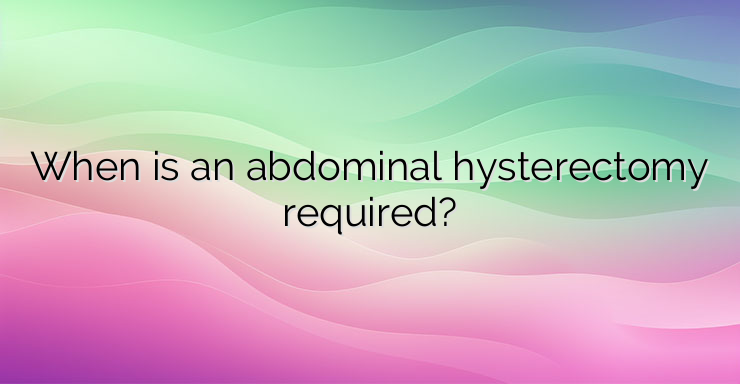An abdominal hysterectomy is a surgical procedure in which the uterus is removed through an incision in the lower abdomen. In a partial hysterectomy, only the uterus is removed, leaving the cervix intact. A total hysterectomy removes both the uterus and the cervix at the same time. Sometimes a hysterectomy involves removing one or both ovaries and fallopian tubes. Then it is called total hysterectomy with salpingo-oophorectomy. A hysterectomy can also be performed through an incision in the vagina (vaginal hysterectomy) or laparoscopically, as well as using a robotic surgical approach, which uses long, thin instruments passed through small abdominal incisions. Abdominal hysterectomy is recommended over other types of hysterectomy in cases where a large uterus is observed, when it is necessary to check other pelvic organs for signs of disease, and at the discretion of the operating surgeon. What are the cases that require the removal of the uterus? Gynecological tumor If cancer of the uterus or cervix is present, a hysterectomy may be the best treatment option. Depending on the specific carcinoma in your case and how advanced it is, other options may include radiation therapy or chemotherapy. Uterine Fibroids Hysterectomy is the only safe, permanent solution for treating uterine fibroids – benign tumors of the uterus that often cause persistent bleeding, anemia, pelvic pain, or pressure on the bladder. Non-surgical treatment of fibroids is possible depending on the level of discomfort and the size of the tumor. Many women with fibroids have minimal symptoms and do not need surgical treatment. Endometriosis In endometriosis, the tissue lining the inside of the uterus (endometrium) grows outside of it on the ovaries, fallopian tubes, and/or other pelvic or abdominal organs. When medications or conservative surgery do not improve the endometriosis, a hysterectomy may be necessary along with removal of the ovaries and fallopian tubes (bilateral salpingo-oophorectomy). Uterine Prolapse Uterine prolapse into the vagina can occur when the supporting ligaments and tissues weaken. Uterine prolapse can cause urinary incontinence, pelvic pressure, or difficulty having a bowel movement. Abnormal vaginal bleeding For heavy or irregular menstruation, hysterectomy may provide relief when bleeding cannot be controlled by other methods. Chronic Pelvic Pain Sometimes surgery is a last resort for women who experience chronic pelvic pain that is proven to originate in the uterus. However, hysterectomy does not relieve many forms of pelvic pain, and unnecessary removal of the uterus can in turn create new problems. A hysterectomy ends a woman’s ability to get pregnant. Before undergoing the procedure, it is necessary to look for alternative ways of treatment. In case of malignant carcinoma,hysterectomy may be the only treatment option. But for other conditions—including fibroids, endometriosis, and uterine prolapse—less invasive treatments need to be tried. Abdominal hysterectomy leads to so-called surgical menopause. With it, menopause symptoms often start abruptly in women after the procedure. Depending on how much these symptoms affect the quality of life, short-term treatment with hormone replacement therapy may be used. A hysterectomy is usually very safe, but as with any major surgery there is a risk of complications. Risks associated with abdominal hysterectomy include: Blood clots; Infection; Excessive bleeding; Adverse reaction to anesthesia; Damage to the urinary tract, bladder, rectum, or other pelvic structures during surgery that may require additional surgical repair; Earlier onset of menopause, even if the ovaries are not removed. References: 1. https://pubmed.ncbi.nlm.nih.gov/7333047/ 2. Aarts JW, Nieboer TE, Johnson N, Tavender E, Garry R, Mol BW, et al. Surgical approach to hysterectomy for benign gynecological disease. Cochrane Database of Systematic Reviews 3. Tohic AL, Dhainaut C, Yazbeck C, Hallais C, Levin I, Madelenat P. Hysterectomy for benign uterine pathology among women without previous vaginal delivery. Obstet Gynecol


Leave a Reply